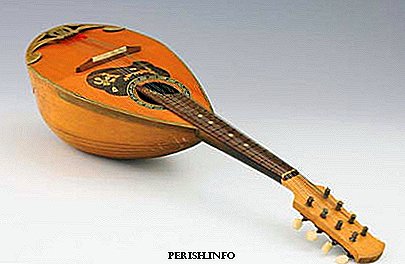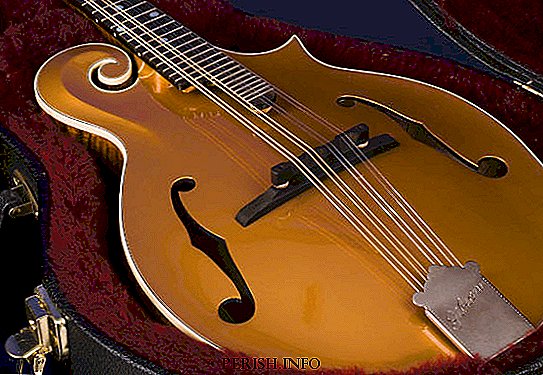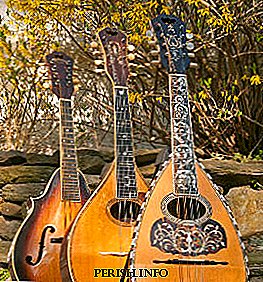Mandolin

Italy ... An interesting country, attracting to itself the rich heritage of the ancient world and the Renaissance. Traveling along it gives people only positive emotions and breathes in the heart of romance. The Eternal City of Rome with the monument of ancient architecture, the Colosseum, magnificent Venice with gondolas and gondoliers, Milan with the world center of operatic culture, La Scala and Naples theater with nearby Vesuvius, and where you can see a young man singing his serenade in the evening with his windows sweetheart. This tradition, singing serenades under the window of the chosen one, accompanying itself on the mandolin, an instrument that became the symbol of Naples, originated in the Middle Ages and is still preserved. Mandolin is a stringed and plucked instrument that appeared during the times of brave knights and beautiful ladies, and is primarily associated with Italian musical culture. It has won love and popularity in many countries of the world and is actively used not only in Italy, but also in Australia, Belgium, Brazil, Croatia, Finland, France, Greece, Ireland, Israel, Japan, Portugal, Romania, Great Britain, the USA and Venezuela.
Sound
The mandolin, which has great technical and artistic capabilities, has a rich, soft, but at the same time quickly fading sound. Velvet, quivering timbre of the instrument is characterized by warmth and tenderness. The source of sound on the mandolin is strongly stretched paired strings, which, clamping on certain frets, extract the desired pitch. The instrument is usually played with a mediator. The main methods of picking up the instrument are strikes up and down on the strings, as well as tremolo, since long notes on the mandolin are played only by this technique. In addition to the basic methods, to achieve artistic goals, musicians use other methods of sound extraction, used when playing other stringed-plucked instruments, for example, a guitar. These are pizzicato, flageolets, glissandos, vibrato, arpeggios, bend (pull-up), rasgeado, pulgar, tambourine, flageolets and various melismas.
The most popular mandolin, which received the name "Neapolitan", is also tuned like a violin, according to quints: salt, re, la, mi. The range of the instrument is in the range from the salt of the small to the fourth octave. The notes for the mandolin are recorded in the treble clef and correspond to the real sound.
A photo:




Interesting Facts
- The mandolin musician is called a mandolinist.
- Mandolin is considered one of the easiest to learn.
- The famous violin maker A. Stradivari made not only the instruments of the violin family, but also the mandolins. Today there are two famous instruments of the master, one of which is stored in the National Museum of Music at the University of South Dakota Vermillion (USA).
- It was the mandolin that was the very first string instrument produced in 1894 by the world famous Gibson company (USA), specializing in the production of musical instruments.
- In the United States, to increase demand, manufacturers specifically recruited musicians to create mandolin orchestras, thereby encouraging people to buy instruments. Some groups, organized at the beginning of the last century, still exist today.
- Legendary musicians Jimmy Page ("Led Zeppelin") and Paul McCartney ("Beatles") played their mandolin in their compositions.
- The electric mandolin was designed in the USA in the 1930s.
- “Neapolitan orchestras” were and still are very popular all over the world - these are the groups that include mandolins of different sizes. In the 19th century, the Italian queen Margherita of Savoy made music in such an orchestra.
- Ancient mandolins made by representatives of the famous Neapolitan dynasty of Vinaccia, which consisted of nine masters: Vincenzo, Giovanni, Domenico, Antonio Gaetano, Gennaro, Pasquale, Gennaro and Achilles, today are in different museums around the world. These are the London Victoria and Albert Museum (England), the Museum of Musical Instruments in Claremont, California (USA), the Royal Conservatory of Brussels (Belgium), the Barcelona Music Museum (Spain).
- The mandolin decorates with its sound the compositions of such famous rock bands as "Led Zeppelin", "Styx", "R.E.M.", "Blackmore's Night", "Nightwish", "Aria", "DDT", "Epidemic", "In Extremo".
Application and Repertoire
Having survived the rise of popularity, and sometimes even periods of oblivion, the mandolin today is again a very popular instrument, which is widely used not only in the classics, but also in various modern styles of music. Folk, country, bluegrass, jazz, blues, ethno, pop, rock, Celtic music, rock and roll - this is just a small list of musical directions and compositions that the mandolin adorns with its sound. The range of application of this universal musical instrument is very wide. It sounds great on stage, both solo and accompaniment. Mandolin is also perfectly combined in ensemble with other instruments, including those that are part of the symphony orchestra.
Mandolin, from the very beginning of its appearance, its beautiful and noble sound attracted the attention of composers. Her repertoire is quite rich and diverse. Of particular note are the concerts for the mandolin A. Vivaldi, D. Pergolesi, D. Paisiello, F. Lecce, R. Kalache, A. Kaufmann - these are works that have become the pearls in the repertoire of this instrument. VAMozart, D. Ligeti, D. Verdi, A. Schoenberg used the mandolin sound in their opera performances. G. Mahler, A. Schoenberg, A. Webern, O. Respighi, I. Stravinsky, S. Prokofiev, R. Shchedrin introduced it into the symphony orchestra. L.V. Beethoven and N. Paganini also diversified the mandolin repertoire, having composed several works for her. There are a lot of composers who wrote for the instrument, however, the mandolin's artistic and technical capabilities were most clearly revealed in the works of I. Hummel, B. Bortolazzi, M. Giuliani, I. Vangala, C. Muniera, G. Galya, H. Baumann, Z. Berenda , N. Shupuronguru, A. Dorman, S. Ranieri, M. Takano, D. Kraton and others.
Performers

Mandolin has always attracted a lot of attention of not only amateurs, but also professional musicians. Already in the second half of the 18th century, during the heyday of the baroque mandolin, mandolinists P. Leon, J. Gervasio, P. Denis and P. Fuchetti had a great reputation, who by their art made a significant contribution to the development of performance skills. The Golden Age of the mandolin, which began at the end of the 19th century, revealed such outstanding performers as D. Pettine, R. Kalache and S. Ranieri, P. Vimercati. Their baton in the 20th century was continued by B. Monroe, D. Apollo, D. Burns, J. Bandolim, D. Grisman. Currently, there are many wonderful performers who do a lot to maintain the popularity of the instrument with their art, delighting listeners. Among them: J. Reuven, A. Avital, A. Sariel, K. Auonzo, D. Brent, K. Lichtenberg, E. Marlin, M. Marshall, D. Staats, E. Stattman, A. Steffi, K. Teel, V. Gill, R. Skaggs, B. Osborn, M. Maguire, M. Kang, L. Cohen.
Design
Mandolin is a tool, as well as a violin requiring long and hard work from the master. Its design includes the body and, ending with the head, neck.
The mandolin body, often pear-shaped, consists of a body and a deck.
- The body that plays the role of the resonator consists of several segments, which are called rivets. It is made from maple, ebony, rosewood or cherry wood. Attached to the body is an engraved tailpiece made of metal, wood or bone.
- The deck, which is the front part of the body, in the classical version has a vocalum - a resonator hole, which is traditionally decorated with inlay. On the deck, which has a small bend, a stand for strings that does not have a strong attachment is installed.
- The neck of the mandolin is relatively short. In its manufacture is used larch, cedar, maple or mahogany. The neck of the metal sills is divided into frets, the number of which varies from 11 to 24 and ends with a hammer head, necessary for stringing the strings.
The total length of the mandolin is 60 cm, of which 33 cm is the length of the body.
The sound on the mandolin is extracted using a plectrum mediator, the preferred material for which the tortoise shell is considered. At the present time, plectrum is also made from various synthetic plastics.
Varieties

The family of mandolins in the process of evolution has acquired a significant number of species that differ in shape of the body, the number of strings and range.
- Florentine mandolin - has 5 paired strings.
- Milan - she has 6 paired strings tuned an octave higher than the strings of a guitar.
- Sicilian (Mandriola) - has 4 strings, tunable in unison, and the lowest sometimes in an octave. This type of mandolin is used in the music of the peoples of Mexico.
- Portuguese - with a flat case. On the top deck, instead of a voice hole, resonator efs are located, in shape resembling violin ones. The instrument features a sharp sound and is used in the music of the peoples of Ireland, Britain, Brazil, and the USA.
The following types of mandolin are actively used in ensemble and orchestral practice and differ in size and pitch.
- Mandola - has 4 paired strings, tuned as violin viola strings: C, G, D, A.
- Octave mandolin - build an octave below the mandolin.
- Mandochello - build the cello strings: do, salt, re, la. Mandochello refers to the mandolin, like a cello to a violin.
- Mando-bass is a large tool, maybe both four-string and eight-string. The tool can have various settings:
- salt, re, la, mi;
- mi, la, re, salt;
- before, salt, re, la.
Story

The beginning of the history of the mandolin originates in the Middle East. It was there, about six thousand years ago, tools of the lute family appeared in the territory of Ancient Mesopotamia, which, according to the assumptions of art historians, were the founders of the mandolin. The immediate predecessor of the instrument is considered to be a small lute of the soprano range, having from 4 to 6 single or paired catgut strings. It appeared in everyday life and widely spread in the countries of Europe from the XI to the XIV centuries under various names: mandora, mandola or pandurin.
It is believed that the mandolin appeared in Italy in the XVII century as a result of the transformations of its previous instruments. Outwardly, it still resembled a lute in many ways, but the head of the instrument's neck was already straightened. Over time, the mandolin became one of the most beloved folk instruments, quickly spread and gained popularity in different countries.
The special flowering of the mandolin begins in the XVIII century. The instrument, which is gaining popularity among various classes, becomes especially popular in high society for chamber music making. Performing art on the instrument reaches its apogee. Published "School playing the mandolin." In Naples, an updated mandolin was made by craftsmen making musical instruments from the Vinaccia family. She had a curved deck, a deeper body, four paired metal strings, tuned like a violin in fifths. An instrument with a brighter sound is introduced into orchestras performing cantatas, oratorios and operas, and composers write music designed specifically for the mandolin. Soon, following the pattern of the new instrument, the mandolins are created in various sound ranges, which later became part of ensembles and orchestras, and later became known as Neapolitan ones.
The beginning of the XIX century for the mandolin was not very supportive, other instruments, with a more intense and expressive sound, displace it from the concert venues. Mandolin loses its popularity and is used only in Italy as a folk instrument. The demand for mandolins falls, and many music masters stop making it. The situation changed only after in 1835 Pasquale Vinaccia radically transformed the classical mandolin. To achieve more volumetric resonance, it increases the size of the body, lengthens the neck, and accordingly adds the number of frets, thereby expanding the range of the tool. The master changed simple wooden pegs for a mechanism that better kept up the strong tension of metal strings, and with it the construction of the instrument. Such a modernization has significantly changed the characteristics of the instrument and made it possible for the performers to achieve a brighter, more vibrant sound in accordance with the requirements of the music of the Romantic era.
The second half of the XIX century is characterized by the beginning of a new round of enthusiasm for the mandolin, and with it its revival. The instrument very quickly conquers various classes, from commoners to crowned persons, and again gains the approval of professional musicians, who again bring it to the concert stage. The tool is rapidly gaining popularity not only in Europe, but also in the United States and Japan. Canada and Australia. For the mandolin begins its "Golden Age".
In the 20th century, due to the use of the mandolin in musical styles like country, blues and jazz, the instrument becomes even more popular.
Mandolin is an interesting musical instrument, which has stepped over to us through the centuries and at the present time is very respected. In many countries, he received the status of the national and is increasingly rooted in modern culture. The popularity of the mandolin is constantly increasing and its sound is increasingly used in new musical genres.

Leave Your Comment